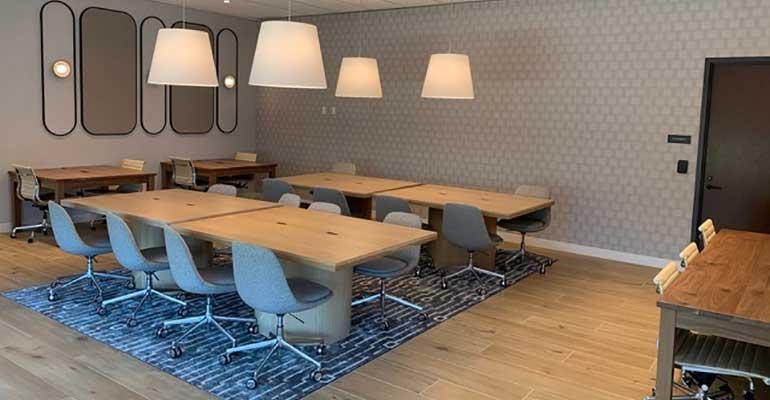Common areas remain silent at many apartment buildings—emptied out to avoid spreading the coronavirus. But residents still need services and amenities, especially as they spend more time on site than normal. That’s forcing innovation and adaptation on the part of apartment owners and managers.
Parents need activities for children home from school. People forced to work out of home need co-working space. Others would like a place to exercise other than their living room rugs.
Apartments companies have found ways to provide services while continuing to follow best practices and regulations to protect their residents from the coronavirus. Sometimes that means livestreaming content that in a pre-COVID-19 world was normally part of in-person programming. In other jurisdictions, residents have been allowed to return to common areas—at reduced levels of occupancy set by local health officials.
“People are craving feeling connected,” says Devin Wirt, CEO of TFLiving, a company based in Pawley, S.C., that arranges amenities and services at more than 180,000 rental apartments.
Residents gather over the Internet or outdoors
In many communities, property managers have tried to create opportunities to connect via the Internet.
“Many properties are doing creative events virtually like tastings, craft events and virtual happy hours,” says Marcia Bollinger, senior vice president of multifamily for Apartments.com.
Residents can also take fitness classes online. TFLiving’s instructors film their classes in their own homes. The video from each of these classes is shared with the renters at 10 to 15 apartment properties. The residents who attend these virtual classes can send messages to instructors to ask questions or share comments. The cost of instructors’ time is also shared between those communities—so it’s less expensive than live instruction for each property.
“Budgets for resident experiences have gone down,” says TFLiving’s Wirt.
However, residents are eager to return to in-person events, wherever local health regulations allow it. “They want to see their old fitness instructor back and be able to talk to them,” says Wirt. In all, Wirt estimates that between 5 percent and 10 percent of the communities TFLiving serves have been able to resume in-person programming.
In some jurisdictions, local rules allow apartment companies to hold events like fitness classes outdoors. “A lot of these places had an open public park or rooftop space,” says Wirt.
And outdoor spaces in general are a big selling point both for individual units and apartment communities in general.
“Balconies and patios are really important right now, as people want to ‘get outside’ for a bit with the shelter in place situations,” says Bollinger. “A breath of fresh air on a patio is refreshing… Common area amenities are still important to residents so they can enjoy a swimming pool, walk their dog in the pet park or cook on the BBQ grill.”
Some indoor common areas are open
Other indoor building amenities are partially open. Spaces like lobbies, laundry rooms and mail rooms never closed, though property managers applied rules set by local health officials to the letter to manage occupancies and enforce mask-wearing where those mandates exist.
“Their hands are tied in many cases by state and local regulations that tell you what you can and cannot do,” says Rick Haughey, vice president of industry technology initiatives for the National Multifamily Housing Council (NMHC).
Experts now largely agree that the coronavirus often spreads through the air, especially indoors in spaces with poor ventilation in which viral particles can hang in the air for more than an hour and spread widely. For safety in the pandemic, health experts recommend a tough standard of six to nine air changes per hour in rooms where people gather—at least twice the standard required by many building codes.
Regulations often limit how many people can be in a space at one time.
With that in mind, exercise classes are conducted in person in very few places. Of all the communities TFLiving serves, only three have attempted to hold fitness classes indoors, in well-ventilated rooms with relatively few participants—typically just two or three in a room at least 200 sq. ft. in size, says Wirt.
Many managers had to remove equipment from fitness centers or furniture from building lobbies to discourage people from crowding too close or staying too long. Communities that provided fast, wireless Internet service to co-working areas have often turned it off, in addition to removing coffee machines.
In some jurisdictions, managers even had to bolt furniture to the floor around swimming pools to keep residents from moving chairs too close together, says Sarah Yaussi, vice president of business strategy for NMHC.
Building for the future, sometime in the future
Living through the pandemic is likely to increase the value that renters put on certain amenities. For example, they are likely to value common areas designed for co-working, now that so many people have gotten used to working from home.
“You’re going to have an onslaught of demand for co-working spaces,” says Wirt.
But developers are not rushing to build more of these spaces while the coronavirus continues to spread. Little construction is happening today that wasn’t already planned before the pandemic, says Haughey.
Residents are able to sit down and work at the formal co-working spaces at 10K and One Hill South, which are two new apartment buildings located next to each other in Washington, D.C. Related Companies built out these spaces with conference rooms and quiet desk space to make phone calls. However, in many places access to co-working spaces like these is currently limited to slow the spread of the coronavirus.





